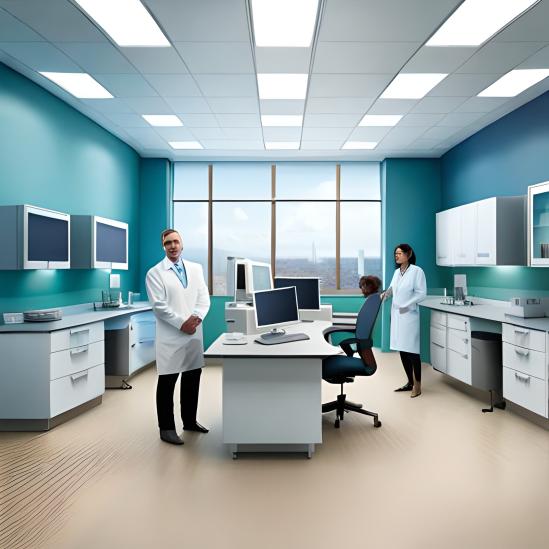
Introduction
Healthcare institutions often encounter significant challenges when it comes to affording expensive medical equipment. Limited budgets and financial constraints can hinder their ability to provide optimal patient care. However, there is a potential solution that can address these budgetary concerns – refurbished medical equipment. Refurbished equipment offers a cost-effective alternative to purchasing new, helping healthcare providers overcome financial hurdles while still accessing advanced technology.
Understanding Refurbished Medical Equipment

Refurbished medical equipment refers to previously owned medical devices that undergo a comprehensive process of assessment and restoration. These devices may have been previously used, returned due to a defect, or even sourced from retiring healthcare facilities. However, they are carefully refurbished to ensure they meet stringent quality assurance standards before being reintroduced into the market.
The refurbishment process entails meticulous cleaning, repairing, and, if necessary, the replacement of faulty or worn-out components. This process not only restores the functionality of the equipment but also ensures that it aligns with current regulatory standards. Once the refurbishment is complete, the equipment undergoes rigorous testing and certification to guarantee its safety and usability.
Benefits of Refurbished Medical Equipment
Cost-effectiveness in comparison to purchasing new equipment
One of the most significant advantages of opting for refurbished medical equipment is the substantial cost savings it offers healthcare institutions. While new equipment can be exorbitantly expensive, refurbished equipment provides a cost-effective alternative without compromising quality or performance. By choosing refurbished options, healthcare providers can allocate their limited budgets more efficiently, enabling them to invest in other areas of patient care.
Access to advanced technology at a fraction of the cost
Refurbished medical equipment allows healthcare institutions to access advanced technological devices that may have otherwise been financially out of reach. With refurbished options, medical facilities can benefit from cutting-edge innovations without overspending. This accessibility to state-of-the-art equipment empowers healthcare professionals to provide improved diagnoses, treatments, and overall care to their patients.
Commonly Refurbished Medical Equipment
Refurbished medical equipment covers a wide range of devices across various healthcare specialties. Here are some examples:
- Imaging equipment such as MRI machines, CT scanners, ultrasounds, and X-ray machines. These essential diagnostic tools help healthcare professionals visualize internal structures, aiding in accurate diagnosis and treatment planning.
- Laboratory equipment including microscopes, analyzers, centrifuges, and autoclaves. These devices play a vital role in laboratory testing, allowing for accurate and efficient analysis of samples, leading to more precise diagnoses.
- Surgical equipment like lasers, endoscopes, surgical tables, and anesthesia machines. This equipment enables surgeons and operating room teams to perform complex procedures with precision, ensuring optimal patient outcomes.
- Patient monitoring systems encompassing ECG machines, vital signs monitors, and pulse oximeters. These devices provide real-time data on a patient’s health status, allowing healthcare providers to monitor and respond to any significant changes quickly.
- Rehabilitation and therapy equipment such as treadmills, stationary bikes, and electrotherapy devices. These tools are crucial for patients undergoing rehabilitation programs, helping them regain strength, mobility, and overall functional independence.
The Refurbishing Process
The refurbishing process is a comprehensive and meticulous undertaking that involves several key stages to ensure the quality and reliability of the equipment.
Assessment and evaluation of equipment for refurbishment
During this initial stage, the refurbished medical equipment undergoes a thorough assessment to determine its suitability for refurbishing. Skilled technicians examine the device, assessing its functionality, condition, and potential for restoration. This evaluation helps identify any underlying issues and guides the refurbishment process.
Cleaning, repairing, and replacing components
Once the assessment is complete, the equipment undergoes a detailed cleaning process to eliminate any contaminants and ensure a sterile environment. Subsequently, skilled technicians repair or replace any faulty or worn-out components necessary for the equipment’s proper functioning. This meticulous approach guarantees that the refurbished equipment operates optimally and meets industry standards.
Calibration and quality control measures
After the repairs and replacements are complete, the equipment goes through calibration to ensure its accuracy and precision. This calibration process aligns the device with established standards, making it reliable for clinical use. Quality control measures, including performance testing and safety inspections, are also implemented to certify the equipment’s compliance with regulatory guidelines.
Certification and testing before resale
Before being made available for resale, refurbished medical equipment must undergo rigorous testing to validate its performance and safety. Only when the equipment passes these thorough tests is it certified for use in healthcare settings. This certification provides both healthcare providers and patients with the assurance that the refurbished equipment meets the necessary quality standards.
Ensuring Quality and Safety
Ensuring the quality and safety of refurbished medical equipment is paramount to its successful implementation in healthcare practices. Several key factors contribute to this objective.
Compliance with regulatory standards and certifications
Refurbished medical equipment must meet and adhere to the same regulatory standards and certifications as new equipment. This ensures that the equipment is safe to use and performs accurately. Healthcare institutions should prioritize working with reputable refurbishing companies that consistently demonstrate compliance with these standards.
Warranty and service support for refurbished equipment
To further guarantee quality and safety, reputable refurbishing companies provide warranties and comprehensive service support for their refurbished equipment. This commitment ensures that any unforeseen issues with the equipment will be promptly addressed, minimizing downtime and disruption to patient care.
Ensuring sterility and infection control
Proper cleaning and sterilization protocols play a critical role in ensuring the sterility and infection control of refurbished medical equipment. Reputable refurbishing companies employ rigorous cleaning processes that eliminate any potential contaminants, thus minimizing the risk of cross-contamination within healthcare settings.
Reputable Sources for Refurbished Medical Equipment
Healthcare institutions seeking to acquire refurbished medical equipment should consider reliable sources to guarantee quality and reliability.
Accredited refurbishing companies
Collaborating with accredited refurbishing companies is a prudent choice for healthcare institutions. These companies possess the necessary expertise and adhere to rigorous standards, ensuring the refurbished equipment meets industry requirements. Accredited companies also offer warranties and ongoing service support, reinforcing their commitment to customer satisfaction.
Collaboration with reputable suppliers and manufacturers
Establishing collaborations with reputable suppliers and manufacturers can also lead healthcare institutions to dependable sources of refurbished medical equipment. These partnerships often provide access to a wide range of high-quality devices, giving healthcare providers peace of mind when making purchasing decisions.
Government programs and initiatives promoting the use of refurbished equipment
Government programs and initiatives aimed at promoting the use of refurbished medical equipment can be valuable resources for healthcare institutions. These programs often offer financial incentives or grants to encourage the adoption of refurbished equipment, further supporting the affordability and accessibility of such devices.
Success Stories: Healthcare Institutions using Refurbished Equipment
Numerous healthcare institutions have successfully implemented refurbished medical equipment, reaping benefits both for their patients and their financial sustainability. These success stories highlight the positive impact of choosing refurbished equipment.
Case studies demonstrating successful implementation of refurbished equipment
Case studies from various healthcare institutions showcase the successful integration of refurbished medical equipment into their practices. These studies often reveal significant cost savings, improved patient outcomes, and enhanced overall efficiency within their healthcare delivery systems. Examples range from hospitals and clinics to research facilities, demonstrating the versatility and effectiveness of refurbished equipment across diverse healthcare settings.
Positive impact on patient outcomes and financial sustainability
Healthcare institutions that have embraced refurbished equipment have witnessed notable improvements in patient outcomes. The accessibility to advanced technology at reduced costs allows medical professionals to offer cutting-edge, evidence-based care that ultimately leads to better patient experiences and health outcomes. Additionally, the financial sustainability of these institutions benefits from the budget-friendly nature of refurbished equipment, enabling them to allocate resources to other critical areas.
Overcoming Stigma and Misconceptions
Despite the numerous advantages of refurbished medical equipment, there may be lingering skepticism and misconceptions surrounding its reliability and performance. It is crucial to address these concerns to ensure the adoption of refurbished equipment.
Addressing concerns about reliability and performance
Refurbished medical equipment undergoes a rigorous refurbishment process, ensuring that any defects or faults are rectified. By partnering with reputable refurbishing companies and adhering to regulatory standards, healthcare institutions can secure high-quality refurbished equipment that performs comparably to new devices. It is essential to educate healthcare professionals about the refurbishing process and the rigorous quality control measures employed to alleviate any skepticism.
Educating healthcare professionals about the benefits of refurbished equipment
Education plays a fundamental role in overcoming skepticism and fostering support for the adoption of refurbished medical equipment. Healthcare professionals need to be informed about the financial benefits, technological advancements, and positive impact on patient care that refurbished equipment can provide. By educating them about these advantages, healthcare institutions can shape a more open-minded and accepting attitude towards utilizing refurbished equipment.
Factors to Consider Before Purchasing Refurbished Medical Equipment
While refurbished medical equipment offers numerous benefits, healthcare institutions should consider several factors before making a final purchasing decision.
Compatibility with existing infrastructure
Healthcare institutions must ensure that any refurbished equipment they consider is compatible with their existing infrastructure. Compatibility encompasses factors such as connectivity, integration with electronic health record systems, and compatibility with existing accessories or supplies. Verifying compatibility before purchasing can help prevent headaches and additional expenses down the line.
Evaluating long-term cost-effectiveness and return on investment
To maximize the benefits of refurbished equipment, healthcare institutions should evaluate its long-term cost-effectiveness and return on investment. This assessment involves comparing the initial cost savings with potential maintenance and service expenses over the equipment’s estimated lifespan. By considering the total cost of ownership, healthcare institutions can determine the financial viability and sustainability of the refurbished equipment.
Equipment lifespan and future upgrade possibilities
Healthcare institutions should assess the estimated lifespan of refurbished equipment and evaluate its compatibility with future upgrades or enhancements. Understanding the equipment’s lifespan allows healthcare providers to plan for eventual replacement or upgrades. Additionally, verifying the feasibility of future upgrades ensures that the equipment can keep pace with evolving medical technologies and healthcare practices.
Implementing Refurbished Equipment in Healthcare Practices
Successfully implementing refurbished equipment requires careful planning and consideration of several key aspects.
Planning and budgeting for refurbished equipment acquisition
Healthcare institutions should include the acquisition of refurbished equipment in their overall strategic planning and budgeting processes. Allocating adequate resources and setting realistic goals for acquiring refurbished equipment allows for seamless integration into the healthcare practice and ensures a smooth transition.
Training healthcare staff on the use and maintenance of refurbished equipment
Proper training is crucial to enable healthcare staff to effectively utilize and maintain refurbished equipment. Healthcare institutions should provide comprehensive training programs that cover the specific features and functionalities of the refurbished equipment. This training should also encompass routine maintenance procedures and troubleshooting guidelines to ensure the equipment’s optimal performance and longevity.
Integrating refurbished equipment into existing workflows and protocols
To maximize the benefits of refurbished equipment, healthcare institutions should integrate it seamlessly into existing workflows and protocols. This integration requires careful evaluation of how the equipment will be used, ensuring that it aligns with established clinical practices. By fostering a cohesive environment, healthcare providers can fully leverage the advantages of refurbished equipment while maintaining continuity of care.
The Environmental Aspect: Refurbished Equipment and Sustainability
In addition to the financial benefits, refurbished medical equipment contributes to sustainability efforts within the healthcare sector.
Minimizing electronic waste and reducing the carbon footprint
By refurbishing medical equipment, healthcare institutions actively participate in reducing electronic waste generated by the healthcare industry. The refurbishment process extends the lifespan of these devices, ultimately minimizing the need for new manufacturing and reducing the carbon footprint associated with the production and disposal of new equipment. Making environmentally conscious choices aligns with healthcare’s commitment to sustainable practices.
Green initiatives in healthcare through the utilization of refurbished equipment
The utilization of refurbished medical equipment aligns with green initiatives aimed at reducing the ecological impact of healthcare practices. Healthcare institutions that prioritize refurbished equipment contribute to a more sustainable healthcare landscape, minimizing waste generation, and conserving valuable resources. These green initiatives integrate economic viability with environmental responsibility, promoting a healthier planet.
Regulatory Considerations and Legal Compliance
Adhering to local regulations and legal requirements is crucial when procuring and implementing refurbished medical equipment.
Compliance with local regulations and certifications
To ensure legal compliance, healthcare institutions must closely adhere to local regulations governing the acquisition and use of refurbished medical equipment. This compliance ensures that the equipment meets all necessary safety and quality criteria required by local authorities. By prioritizing legal compliance, healthcare institutions not only avoid potential penalties but also safeguard patient safety and maintain their reputation.
Documentation and compliance with healthcare legal requirements
Accurate documentation is vital when procuring refurbished medical equipment. Healthcare institutions must maintain records of the equipment’s refurbishment process, certifications, and compliance with legal requirements. These documents serve as evidence of due diligence and can be requested during regulatory inspections or audits. Comprehensive documentation reinforces transparency and demonstrates a commitment to quality and regulatory compliance.
Potential Challenges and Mitigation Strategies
While the utilization of refurbished medical equipment offers significant advantages, there are potential challenges that healthcare institutions may encounter. Implementing appropriate mitigation strategies can help overcome these challenges.
Limited availability of specific refurbished equipment
Healthcare institutions may encounter difficulties in finding specific refurbished equipment due to its limited availability. To address this challenge, institutions should establish relationships with reputable suppliers and refurbishing companies. Maintaining open communication and providing advanced notice of equipment needs can facilitate the procurement process and mitigate potential complications arising from limited availability.
Ensuring ongoing maintenance, repairs, and spare parts
As with any medical equipment, refurbished devices may require ongoing maintenance, repairs, and replacement of spare parts. Healthcare institutions should establish maintenance contracts with refurbishing companies or qualified technicians to ensure these needs are promptly addressed. Maintaining a readily available inventory of spare parts is also crucial in minimizing downtime and optimizing the equipment’s longevity.
Bridging the Gap: Collaboration between Manufacturers and Refurbishing Companies
Collaboration between original equipment manufacturers (OEMs) and refurbishing companies holds great potential in addressing healthcare budget constraints and equipment accessibility.
Opportunities for collaboration to improve equipment availability
By collaborating, OEMs and refurbishing companies can work together to make refurbished medical equipment more widely available. Such collaborations can involve OEMs providing refurbishing companies with access to spare parts or technical expertise. Enhanced cooperation between these entities expands the availability of refurbished equipment, ultimately benefiting healthcare institutions and patients.
Mutual benefits for manufacturers and refurbishing companies in addressing healthcare budget constraints
Collaboration between manufacturers and refurbishing companies not only helps address healthcare budget constraints but also benefits both parties. Manufacturers gain from reclaiming value from retired or underused equipment, while refurbishing companies can access necessary parts or technical support to enhance their refurbishment capabilities. These mutually beneficial relationships contribute to a sustainable and cost-effective healthcare ecosystem.
Cost Comparison: Refurbished vs. New Medical Equipment
A comprehensive cost comparison is an essential aspect when considering refurbished medical equipment.
In-depth analysis of cost savings and financial impact
To determine the financial impact of choosing refurbished medical equipment, healthcare institutions should conduct an in-depth analysis of the costs associated with both refurbished and new equipment. This analysis typically considers factors such as initial purchase price, maintenance expenses, and potential cost savings over the equipment’s lifespan. A thorough evaluation allows healthcare institutions to make informed decisions based on their unique financial circumstances.
Calculating the potential return on investment of refurbished medical equipment
Calculating the potential return on investment (ROI) is a valuable exercise for healthcare institutions considering refurbished medical equipment. It involves comparing the cost of acquiring and
